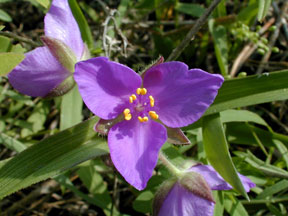LONG-BRACTED SPIDERWORT
|
 |
| File Size: 72 KB |
|
|
|
Tradescantia bracteata Small
|
| Riley County, Kansas |
| Perennial |
| Height: 4-12 inches |
| Family: Commelinaceae - Spiderwort Family |
| Flowering Period: May, June, July |
|
| Also Called: | | Bracted spiderwort. | | Stems: | | Erect, stout, rarely branched, glabrous or sparsely hairy; nodes 2-4; internodes to 8 inches. | | Leaves: | | Alternate, simple, linear-lanceolate, 3 to 12 inches long, 1/3 to 2/3 inch wide, glabrous or sparsely soft-hairy at base, parallel veined, rarely folded; margins entire. | | Inflorescences: | | Cyme, umbel-like, few- to many-flowered, terminal on main stem; bracts large, leafy, 2 to 12 inches long, glabrous to soft-hairy; folded lengthwise, curving downward, often longer and wider than leaves. | | Flowers: | | Stalks densely soft-hairy, sepals 3, elliptic, pointed, 1/3 to 1/2 inch long, soft-hairy, margins sometimes purple; corollas 1 to 1.5 inch wide, blue, purple, or rose; petals 3, stamens 6, filaments densely bearded. | | Fruits: | | Capsules, rounded; seeds 2-6, flattened, gray. | | Habitat: | | Moist prairies, roadsides, and disturbed sites. | | Distribution: | | East 2/3 of Kansas. | | Uses: | | The young stems and leaves can be used raw in salads or cooked as a food seasoning. The Lakota made a jelly-like blue paint from the flowers, which was used for decorative purposes. | | Comments: | | Tradescantia is named for John Tradescant, gardener for Charles the First of England in the 17th century. | | | | Three other spiderworts are observed in Kansas: common spiderwort , prairie spiderwort , and Tharps' spiderwort . |
|
| Long bracted spiderwort |  | | 49 KB | | Riley County, Kansas |
| | Long bracted spiderwort stamens and filaments |  | | 68 KB | | Riley County, Kansas |
| | Long bracted spiderwort |  | | 84 KB | | Riley County, Kansas |
| | Long bracted spiderwort flowers and sepals |  | | 64 KB | | Riley County, Kansas |
| | Long bracted spiderwort |  | | 151 KB | | Tallgrass Prairie National Preserve, Chase County, Kansas |
|
|
|
|
|
|
|